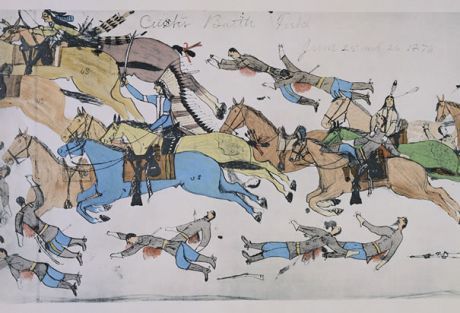Features
You are here
140 years ago: victory at the Battle of Little Bighorn

June 25, 2016
Today is the 140th anniversary of one of the greatest battles of Indigenous resistance, the Battle of Greasy Grass/Little Bighorn—where Crazy Horse and Sitting Bull led a land defense against the colonial troops of George Custer.
Custer the colonizer
Roxanne Dunbar-Ortiz describes the context in An Indigenous Peoples' History of the United States: “At the end of the Civil War the US Army hardly missed a beat before the war ‘to win the West’ began in full force. As a far more advanced killing machine and with seasoned troops, the army began the slaughter of people, buffalo, and the land itself, destroying the natural tall grasses of the plains and planting short grasses for cattle, eventually leading to the loss of the topsoil four decades later.”
Some Indigenous leaders hoped complying with the colonial government would bring peace, like Black Kettle who took his community to live in the Sand Creek reservation. But the military attacked anyway, massacring more than 150 people in 1864. Others resisted: when the military went to enforce the gold rush in 1866 on Indigenous territories in Wyoming and Montana, Lakota chief Red Cloud and Crazy Horse led the resistance—wiping out Captain Fetterman and his troops.
The US government responded with false peace and more war—signing the Treaty of Fort Laramie in 1868 that respected unceded territory in the Black Hills, while unleashing more violence. As Dunbar-Ortiz writes, “Following this event (defeating Fetterman), General Sherman wrote to Grant, who was still army commander: ‘We must act with vindictive earnestness against the Sioux, even to their extermination, men, women, and children.’ Sherman made it clear than ‘during an assault, the soldiers can not pause to distinguish between male and female, or even discriminate as to age.’ In adopting total war in the West, Sherman brought in its most notorious avatar, George Armstrong Custer, who proved his mettle right away by leading an attack on unarmed civilians on November 27, 1868, at the Southern Cheyenne reservation at Washita Creek in Indian Territory…The Seventh Cavalry murdered over a hundred Cheyenne women and children that day, taking ghoulish trophies afterward.”
Battle of Greasy Grass/Little Bighorn
In 1874 Custer led a military expedition into the Black Hills in search of gold, triggering a gold rush. The US government violated the 1868 Treaty that honoured Indigenous control of the Black Hills, demanding all Lakota and Cheyenne live on reservation by February 1876 or be considered “hostile.” As Commissioner of Indian Affairs wrote, “without the receipt of any news of Sitting Bull’s submission, I see no reason why…military operations against him should not commence at once.”
Chief Sitting Bill had united Lakota, Cheyenne and Arapaho who refused to comply with the colonial government, and they resisted the military sent against them. On March 17 Colonel Reynolds attached a Cheyenne village, but was resisted in the Battle of Powder River. On June 17 Crazy Horse led a force against General Crook in the Battle of the Rosebud, driving him back and preventing him from meeting up with Custer.
Then on June 25, Custer attacked Sitting Bull’s village at the end of the annual Sun Dance ceremony, in the Greasy Grass plains on the Little Bighorn river—in what could have been a repeat of the Sand Creek and Washita Creek massacres. But Sitting Bull and Crazy Horse led the defense of their land and a counter-attack that wiped out all of Custer’s troops and Custer himself.
Defeated in the lead up to the American centenary on July 4, 1876, the US government's response was brutal—continuing the colonial drive and rounding up Indigenous leaders. Crazy Horse surrendered the next year and was assassinated. Sitting Bull went into exile in Canada, where a directive from the colonial government made clear Ottawa’s stance: “The Canadian Indian agents in the Northern District should be notified that they are not to supply Sitting Bill or his followers with food, and not to give them any encouragement whatever.” When he returned to the US he was arrested and assassinated in 1890, and then the reconstituted Seventh Cavalry massacred Lakota people at Wounded Knee.
Legacy
Custer was promoted to general after his death and glorified in monuments and memorials across the country, celebrating “Custer’s Last Stand.” For the next century he was glorified in popular culture—including in portrayals by Ronald Regan and Errol Flynn in films in the 1940s—while Indigenous resistance was demonized.
But in the 1960s and 1970s the Red Power movement rose to fight for Indigenous rights and set history straight: Custer Died for Your Sins, Indigenous historian Vine Deloria Jr titled his widely read book. As Metis historian and activist Howard Adams wrote of Canadian colonialism: "It is this history of courageous struggles of resistance that makes our Indian and Metis heritage so great and glorious. Many died fighting for their freedom, and in the process killed their white enemies in the struggle...Today these victories are popularly labeled as Indian massacres. The distortion of linguistic imperialism has no limits."
The Red Power movement also changed representations on film: Little Big Man, a 1970 film starring Dustin Hoffman, portrayed the real Custer as an arrogant war criminal. It showed the brutality of the Sand Creek and Washita Creek massacres (similar to the My Lai massacres in Vietnam at the time), and sympathized with Indigenous resistance like the Battle of Little Bighorn—and it won numerous nominations and awards for Chief Dan George in his supporting role.
A generation later there is another wave of Indigenous resistance—building on the legacy of Crazy Horse and Sitting Bull in the 1870s, and the Red Power movement of the 1970s.
Join the discussion Indigenous Marxism: the life and politics of Howard Adams, Sunday June 26, 3-5pm at D-Beatstro: 1292 Bloor St West, near Lansdowne, Toronto
Section:










